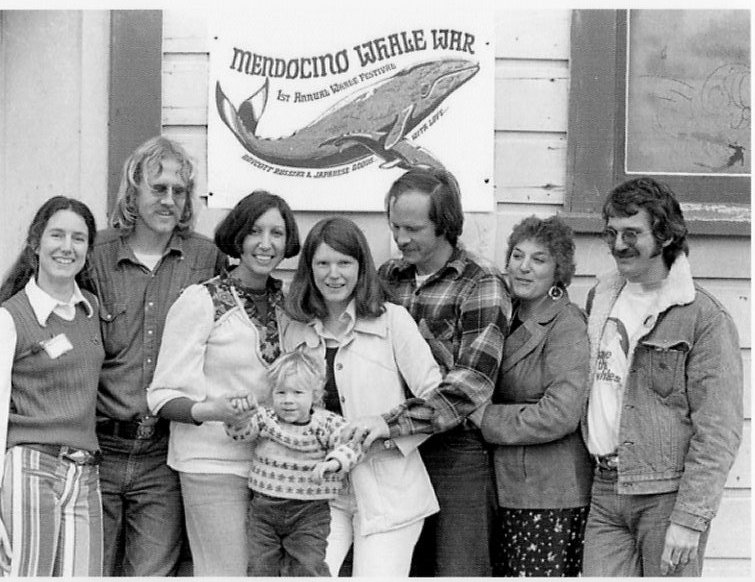Originally printed in the Mendocino Art Center’s Fall 2003 Arts & Entertainment magazine
Every March the annual Mendocino Coast Whale Festival celebrates the migration of the Pacific Gray Whales with their newborn calves from western Baja to the Bering Sea. But this celebration would not be possible without the 1976 Mendocino Whale Wars that helped to save the then-endangered species. The following is an excerpt spotlighting J.D. Mayhew, an artist who used his work to help the whales. The Kelley House Museum has prints of a 1975 Mendocino Coast map created by J.D. Mayhew. The whimsical map depicts the Mendocino Coast from Mendocino to Fort Bragg, complete with whales, hippie buses, and even Mayhew’s own house on Todd’s Point. Prints of the map are for sale online and in the museum.
Only a man truly connected, truly tuned into nature can create this art. J.D. comfortably crosses between and unites the two Kingdoms of land and sea. As a result he depicts their beauty, intelligence, grace and their very essence as though he was one of them and invites viewers to join them.
“The closer you get to them and the wilder the things you see them do, the more you’re fascinated by them. The babies are inquisitive because they’ll come over to the boat and let you rub them. Then the mother whale will come up, sometimes upside down. It doesn’t matter to them. They’ll let you rub under their chin.”
J.D. (James Davis) Mayhew’s personal migration from Enid, Oklahoma (born 09/13/25) to the Mendocino coast in 1971 is a “whale of a tale” and must have been predestined. Upon graduation from Oklahoma City University in 1948, he began a 20-year career as an illustrator/art director in the San Francisco Bay Area. His illustrations frequently appeared in national publications, children’s books and filmstrips. As his successful career peaked with him a business partner, he liquidated his interest in the advertising agency and surrendered to the call of the sea.
With the sea as his backyard, J.D.’s deep affection for these great whales grew as he amassed an important body of work, primarily etchings masterfully printed on handmade papers using copper and zinc plates, until recent years when he’s included watercolors and other mediums.
J.D. became profoundly concerned for the plight of the then-threatened Gray and Humpback whales. Early on he began taking on an active role in the defense of the whales from Russian and Japanese whale hunters along the Mendocino coast. He forged strong friendships with other likeminded artists concerned for the whales and was greatly instrumental in the public recognition of the dangers to whales and the subsequent recovery of these great marine mammals.

Supporters of the Mendocino Whale War pose outside Crown Hall with J. D. Mayhew’s poster for the 1st Annual Whale Festival. From left: Ellen Findlay Herdegen, Bill Wilson, Sue Golden, baby Brenden Cusick, Heidi Cusick, Barry Cusick, Sally Welty, Lee Welty. (Photographer: Nicholas Wilson; Gift of Bruce Levene)
For over 20 years he operated the Mendocino Wildlife Gallery he’d founded in which he showcased emerging wildlife artists and championed many environmental groups. These artists today speak of J.D. with reverence, warmth and love.
His reputation is built also on his personal responsibility for each print, which he regards as an integral part of the creative effort, never to be separated from the drawing and etching. With this level of dedication it stands to reason that he had produced small limited editions, thereby adding the element of rarity that collectors and museums worldwide highly prize.
“Every once in a while I’ll get into a doldrums and think, ‘Oh, I’ve done enough of this.’ And before I know it, I’ll see a whale do something absolutely outrageous and get all keyed up again.”
The Kelley House Museum is open from 11AM to 3PM Thursday through Monday. If you have a question for the curator, reach out to [email protected] to make an appointment. Walking tours of the historic district depart from the Kelley House regularly.